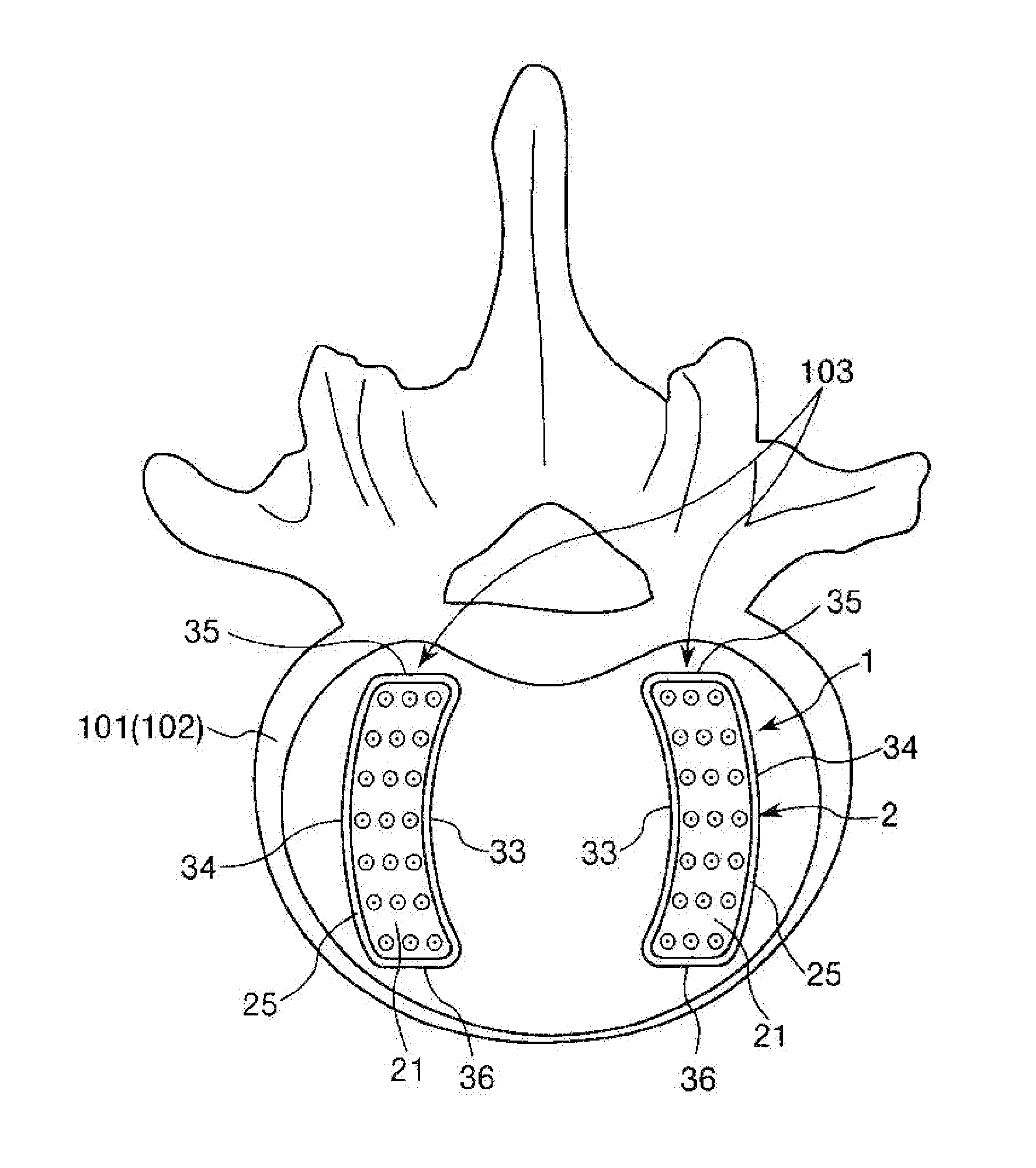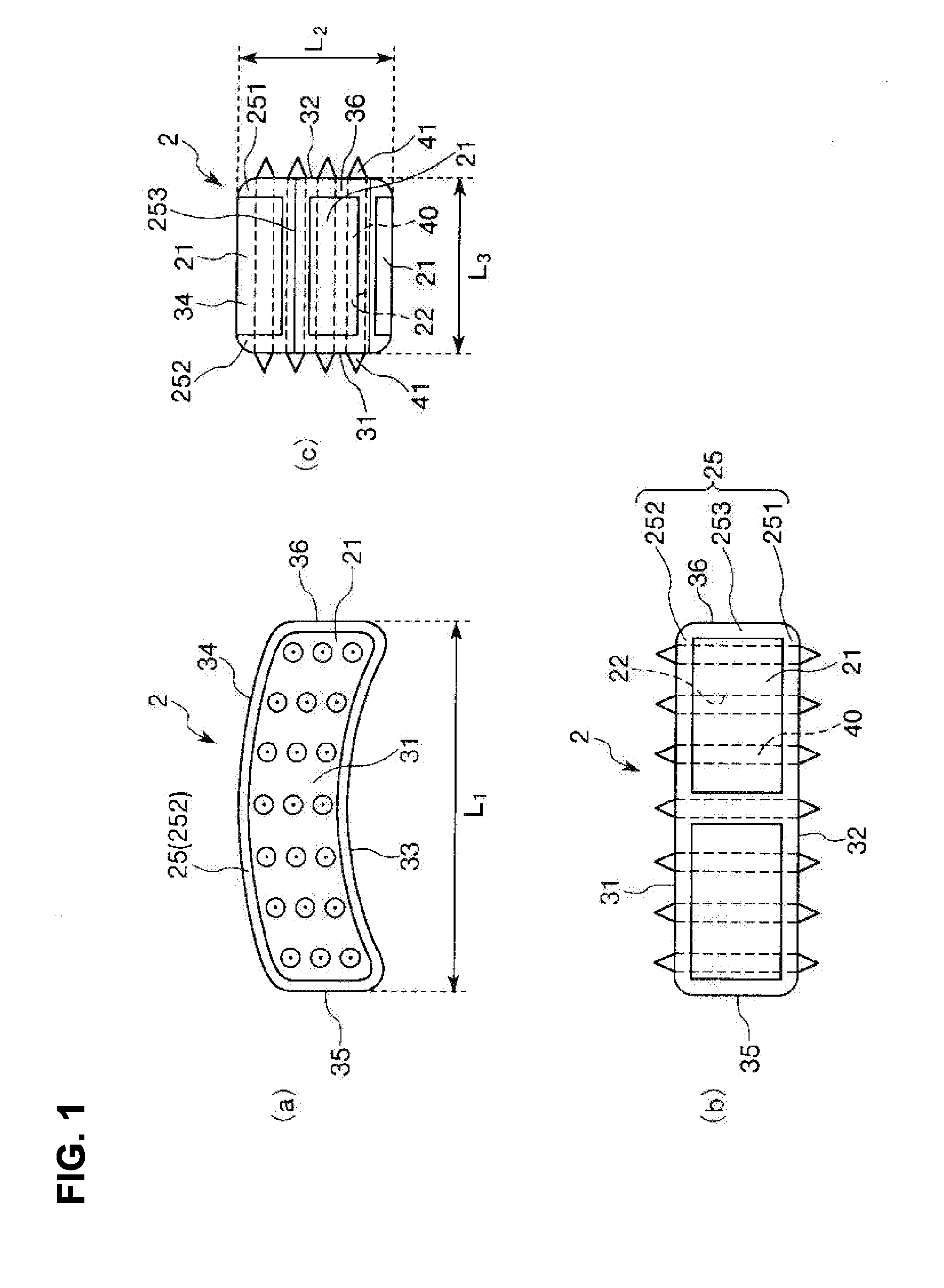Vertebral body spacer
a technology for vertebral bodies and spacers, applied in the field of vertebral body spacers, can solve the problems of insufficient amount of bone to be grafted, inability to harvest autologous bone, and inability to fusing between vertebral bodies, so as to prevent the vertebral body spacer and graft bone more reliably and quickly
- Summary
- Abstract
- Description
- Claims
- Application Information
AI Technical Summary
Benefits of technology
Problems solved by technology
Method used
Image
Examples
first embodiment
[0043]First, description will be made on a first embodiment of the vertebral body space according to the present invention.
[0044]FIG. 1 is a plan view (a), a front view (b) and a side view (c) which show the first embodiment of a block body constituting the vertebral body spacer of the present invention. FIG. 2 and FIG. 3 are a view showing a used state of the vertebral body spacer of the present invention, respectively.
[0045]In the following description, it is to be noted that a state of inserting the vertebral body spacer between vertebral bodies of a case (patient) is defined as a basic state, thereby defining a position thereof, unless it is explicitly stated otherwise.
[0046]Specifically, a ventral side of the patient (namely, a right side in each of FIG. 1(a), FIG. 1(b) and FIG. 2(b), a near side in each sheet of FIG. 1(c) and FIG. 2(a), and a lower side in FIG. 3) will be referred to as “front”, and a dorsal side of the patient (namely, a left side in each of FIG. 1(a), FIG. 1...
second embodiment
[0112]Next, description will be made on a second embodiment of a vertebral body space according to the present invention.
[0113]FIG. 4 is a plan view (a), a front view (b) and a side view (c) which show the second embodiment of a block body constituting the vertebral body spacer of the present invention.
[0114]In the following description, the description will be made on a block body 2 shown in FIG. 4. The description will be made by focusing on different points from the block body 2 shown in FIG. 1 to FIG. 3 and the description on the common points is omitted.
[0115]The block body 2 shown in FIG. 4 is the same as the block body 2 shown in FIG. 1 to FIG. 3, except that a shape of the whole thereof is different.
[0116]In the present embodiment, both a first surface 31 and a second surface 32 constitute a curved convex surface, except an area in which projection portions 41 are provided. The first surface 31 and the second surface 32 are connected to each other at an end portion on a fron...
third embodiment
[0120]Next, description will be made on a third embodiment of a vertebral body space according to the present invention.
[0121]FIG. 5 is a plan view (a), a front view (b) and a side view (c) which show the third embodiment of a block body constituting the vertebral body spacer of the present invention. FIG. 6 is a view showing a used state of the third embodiment of the vertebral body spacer of the present invention.
[0122]In the following description, the description will be made on a block body 2 shown in FIGS. 5 and 6. The description will be made by focusing on different points from the block body 2 shown in FIG. 1 to FIG. 3 and the description on the common points is omitted.
[0123]The block body 2 shown in FIG. 5 is the same as the block body 2 shown in FIG. 1 to FIG. 3, except that a connecting portion 50 of rotatably connecting a pair of block bodies 2 to each other is provided with the pair of block bodies 2.
[0124]In the present embodiment, the connecting portion 50 has a plat...
PUM
| Property | Measurement | Unit |
|---|---|---|
| porosity | aaaaa | aaaaa |
| length | aaaaa | aaaaa |
| length | aaaaa | aaaaa |
Abstract
Description
Claims
Application Information
 Login to View More
Login to View More - R&D
- Intellectual Property
- Life Sciences
- Materials
- Tech Scout
- Unparalleled Data Quality
- Higher Quality Content
- 60% Fewer Hallucinations
Browse by: Latest US Patents, China's latest patents, Technical Efficacy Thesaurus, Application Domain, Technology Topic, Popular Technical Reports.
© 2025 PatSnap. All rights reserved.Legal|Privacy policy|Modern Slavery Act Transparency Statement|Sitemap|About US| Contact US: help@patsnap.com



